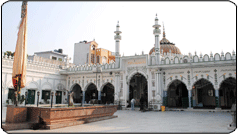Dargah of Hazrat Abbas
Situated in Rustam Nagar in the old city, Dargah Hazrat Abbas is the oldest shrine of the Shia Muslims in Lucknow.
In Iraq, on 10th of Muharrum 61 Hijri (680), when Imam Hussain was forced to camp on the banks of river Eupharates (Faraat) at Karbala, there was not a drop of water in the encampment as the enemy (Yazid's army) had banned the fetching of water from the river since 7th of Muharrum. Hazrat Abbas, the step-brother of Imam Hussain, sought the Imam's permission to fetch water for the thirsty children in their camp. To restrain Abbas from provocation, he was asked to take the alam [a standard with a metal crest crowning the flag] in one hand and the mashkeeza (camel-leather water-bag) in the other. He was thus left with no defence when attacked by the enemy. His mashkeeza was pierced with arrows and his hands were chopped off as he tried to reach the water to the camp. For Shias, the martyrdom of Hazrat Abbas has special significance.
The dargah (shrine) of Hazrat Abbas came into existence during the reign of Nawab Asaf-ud-Daulah (1775-1797). A poor man, Mirza Faqeera Beg, was visited by Hazrat Abbas in his dream and directed to dig out his alam from a specific location in the city. Faqeera went to the site the next morning and discovered a large bronze alam in the shape of a hand (five fingers and a palm). He placed it reverently in his house in Rustam Nagar. Soon the news of the miraculous discovery spread and people started visiting his place with offerings and prayers for the fulfilment of their wishes. Nawab Asaf-ud-Daulah also visited the place and ordered that a dome be erected over the place, in order to convert it to a dargah (shrine).
People from different localities began assembling in the dargah with alams on 7,h of Muharrum [a day which is particularly specified by Shias for honouring Hazrat Abbas]. Later on, the first Thursday after the sighting of moon, called the Nauchandi Jummeraatwas considered auspicious for visiting the shrine and a large number of devotees crowded the dargah on this day. When Asaf-ud Daulah's step-brother Nawab Saadat Ali Khan, was unexpectedly made the ruler of Awadh by the British, after the deportation of the former's son Wazir Ali in January 1798, after a short term of just four months, Saadat Ali Khan got the dome of the dargah gilded in gold. He also built two separate enclosures for male and female visitors to the shrine.
His son, Ghazi-ud-din Haider, who was crowned the first King of Awadh in October 1819, provided a Naubat Khana for the entrance to the dargah in the form of a double storeyed gateway. Naqqara (large drums) were sounded from the gallery on the upper storey of this gateway to inform the hour of the day as well as for ceremoniously greeting members and guests of the royal household on their visit to the shrine. The King also provided the inner sanctum of the shrine where the iconic alam was preserved, with silver foiled doors. He made the further provision of a mimbar (pulpit) fashioned in silver.
Malka Zamani, the favourite queen of Naseer-ud-Din Haider, the second King of Awadh (1827-1837), set up a kitchen at the shrine for free distribution of food to the poor. She visited the dargah on every nauchandi jummeraat with an offering of ten thousand rupees. People on the streets waited eagerly to have a glimpse of her entourage, a procession consisting of a hundred elephants with silver howdah (mounted seat) and gold embellishments. It had a number of palanquins and oxen driven carriages for the accompanying ladies. The queen sat in a large sukhpal (decorated carriage) covered with a brocade silk canopy.
The dargah is also linked with the first Indian war of Independence. In 1858 it became the headquarters of the native sepoys and soldiers in the city who were in rebellion against the British. A leader of the freedom struggle in 1857-58 and one of the chief commanders of Begum Hazrat Mahal's forces, Shah Ahmadullah camped here before leaving for Bareilly. Captured by deceit through the Raja of Pawaian (a State near Shahjahanpur), he was killed in front of the fort at Pawaian by the Raja's brother who was rewarded by the British.
After the rebellion failed, British soldiers plundered Nawabi buildings and the dargah too was not spared. The gold in the dome and alam was removed by the plunderers. Much of the decorative valuables placed in the shrine were taken away and auctioned by the British along with the valuables of Wajid Ali Shah.
Source:
Hindustan Times, City Scan, A Time in History
Wednesday 23.7.1997 — Dargah Hazrat Abbas: A revered shrine

